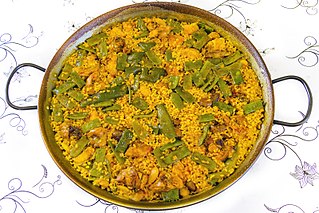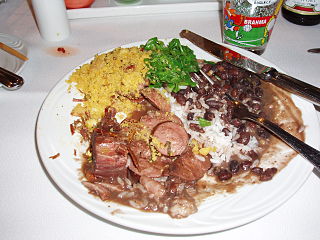
Mexican cuisine consists of the cooking cuisines and traditions of the modern state of Mexico. Its roots lie in Mesoamerican cuisine. Many of its ingredients and methods have their roots in the first agricultural communities such as the Maya who domesticated maize, created the standard process of maize nixtamalization, and established their foodways. Successive waves of other Mesoamerican groups brought with them their own cooking methods. These included the Olmec, Teotihuacanos, Toltec, Huastec, Zapotec, Mixtec, Otomi, Purépecha, Totonac, Mazatec, Mazahua, and Nahua. With the Mexica formation of the multi-ethnic Triple Alliance, culinary foodways became infused. The staples are native foods, such as corn (maize), beans, squash, amaranth, chia, avocados, tomatoes, tomatillos, cacao, vanilla, agave, turkey, spirulina, sweet potato, cactus, and chili pepper. Its history over the centuries has resulted in regional cuisines based on local conditions, including Baja Med, Chiapas, Veracruz, Oaxacan, and the American cuisines of New Mexican and Tex-Mex.

Spanish cuisine consists of the cooking traditions and practices from Spain. Olive oil is heavily used in the Spanish cuisine, and it is the base of many vegetable sauces (sofritos). Hallmark herbs include parsley, oregano, rosemary and thyme. The use of garlic has been noted as "common to all Spanish cooking". Most common meats include chicken, pork, lamb and veal. Fish and seafood are also consumed on a regular basis.

Paella is a Spanish rice dish originally from Valencia.

An enchilada is a corn tortilla rolled around a filling and covered with a savory sauce. Enchiladas can be filled with various ingredients, including meats, cheese, beans, potatoes, vegetables or combinations. Sauces can also be used to cover enchiladas, including chili-based sauces, such as salsa roja, various moles, or cheese-based sauces, such as chile con queso. Originating in Mexico, enchiladas are a common dish in Mexican cuisine.

A sandwich is a food typically consisting of vegetables, sliced cheese or meat, placed on or between slices of bread, or more generally any dish wherein bread serves as a container or wrapper for another food type. The sandwich began as a portable finger food in the Western world, though over time it has become prevalent worldwide.

Chorizo or chouriço is a type of pork sausage.

Organic certification is a certification process for producers of organic food and other organic agricultural products. In general, any business directly involved in food production can be certified, including seed suppliers, farmers, food processors, retailers and restaurants. A lesser known counterpart is certification for organic textiles that includes certification of textile products made from organically grown fibres.

An empanada is a type of baked or fried turnover consisting of pastry and filling, common in Southern European, Latin American, and the Philippines cultures. The name comes from the Galician verb empanar, and translates as "enbreaded", that is, wrapped or coated in bread. They are made by folding dough over a filling, which may consist of meat, cheese, tomato, corn, or other ingredients, and then cooking the resulting turnover, either by baking or frying.

Latin American cuisine is the typical foods, beverages, and cooking styles common to many of the countries and cultures in Latin America. Latin America is a highly diverse area of land whose nations have varying cuisines. Some items typical of Latin American cuisine include maize-based dishes arepas, pupusas, tacos, tamales, tortillas and various salsas and other condiments. Sofrito, a culinary term that originally referred to a specific combination of sautéed or braised aromatics, exists in Latin American cuisine. It refers to a sauce of tomatoes, roasted bell peppers, garlic, onions and herbs.

Adobo or adobar is the immersion of raw food in a stock composed variously of paprika, oregano, salt, garlic, and vinegar to preserve and enhance its flavor. The Portuguese variant is known as Carne de vinha d'alhos. The practice, native to Iberia, was widely adopted in Latin America, as well as Spanish and Portuguese colonies in Africa and Asia.

Mediterranean cuisine is the foods and methods of preparation by people of the Mediterranean Basin. The idea of a Mediterranean cuisine originates with the cookery writer Elizabeth David's book, A Book of Mediterranean Food (1950) and was amplified by other writers working in English. Many writers define the three core elements of the cuisine as the olive, wheat, and the grape, yielding olive oil, bread and pasta, and wine; other writers deny that the widely varied foods of the Mediterranean basin constitute a cuisine at all. A common definition of the geographical area, proposed by David, covered follows the distribution of the olive tree.

Endosulfan is an off-patent organochlorine insecticide and acaricide that is being phased out globally. The two isomers, endo and exo, are known popularly as I and II. Endosulfan sulfate is a product of oxidation containing one extra O atom attached to the S atom. Endosulfan became a highly controversial agrichemical due to its acute toxicity, potential for bioaccumulation, and role as an endocrine disruptor. Because of its threats to human health and the environment, a global ban on the manufacture and use of endosulfan was negotiated under the Stockholm Convention in April 2011. The ban has taken effect in mid-2012, with certain uses exempted for five additional years. More than 80 countries, including the European Union, Australia, New Zealand, several West African nations, the United States, Brazil, and Canada had already banned it or announced phase-outs by the time the Stockholm Convention ban was agreed upon. It is still used extensively in India, China despite laws banning it, and few other countries. It is produced by Makhteshim Agan and several manufacturers in India and China. Although, the Supreme Court had, by an order dated 13.05.2011, put a ban on the production and sale of endosulfan in India till further orders.
Holando-Argentino is a breed of cattle primarily found in Argentina, and derived from Holstein-Friesian Cattle. It was first introduced from the Netherlands in 1880, to the fertile regions of the Pampas, and devoted to the production of both beef and milk.

Sephardic Jewish cuisine is an assortment of cooking traditions that developed among the Sephardi Jews—the Jews of Spain and Portugal, and those of this Iberian origin who were dispersed in the Sephardic Diaspora, and ultimately became the Eastern Sephardim and North African Sephardim as they settled throughout the Mediterranean in places such as Turkey, Greece, the Balkans, as well as the Arab countries of West Asia and North Africa. Cuisine of the Sephardi Jews also includes the cuisine of those who became the Western Sephardim who settled in Holland, England, and from these places elsewhere.

e-Learning Developers' Community of Practice or ElCoP is practice developed following a decision of European air navigation service (ANS) training providers together with Eurocontrol, to create an e-learning developers community of practice in January 2009.

Paprika is a ground spice made from dried red fruits of sweeter varieties of the plant Capsicum annuum. It is traditionally made from Capsicum annuum varietals in the Longum group, which also includes chili peppers, but the peppers used for paprika tend to be milder and have thinner flesh. In many languages, but not English, the word paprika also refers to the plant and the fruit from which the spice is made, as well as to peppers in the Grossum group.

The Ministry of Agriculture, Livestock and Fisheries of Argentina, commonly known simply as the Ministry of Agriculture, is a ministry of the national executive power that oversees production, commerce and health regulations in the agricultural, livestock and fishing industries.
















